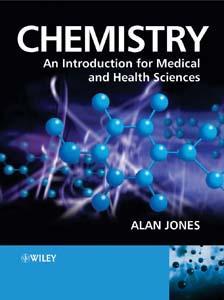Ann Lewis-Kell reviews this introductory text
Chemistry: an introduction for medical and health sciences
Alan Jones
Chichester: Wiley 2005 | Pp270 | £24.95 | ISBN 0 470 09289 0
Reviewed by Ann Lewis-Kell

Intended as an introduction to chemistry relevant to the medical and healthcare sciences, this book is easy to read and can be used either as a textbook or self-teaching aid. This is a concise reference text and thanks to its design and index it will be easy for any student (at whatever level) to find information on a wide range of chemical terms and concepts.
Each of the 15 chapters contains a list of learning objectives and a diagnostic test (with answers) to check previous knowledge and understanding. Every chapter also contains lists of useful references and extension questions to test understanding of the material covered.
The introductory chapters (1-6) provide background information on the atom, the Periodic Table and covalent bonding as well as covering organic chemistry, vitamins, steroids, hormones and enzymes. Subsequent chapters (7-10) cover topics such as the roles water and the major ions play in the body, the roles of acids and bases in digestion, and chemical aspects of oxidation and reduction processes in metabolism. Chapter 11 reviews analytical techniques and chapter 12 provides information on radioactivity and its applications to medicine. Rates of reactions and pharmacokinetics are covered in chapter 13 while chapter 14 focuses on how both ancient and modern drugs are used to fight disease. Finally, any reader will learn a lot about numbers and quantities (eg the mole, the use of logarithms and standard notation) from chapter 15.
Clear diagrams are used throughout and there is an excellent glossary and bibliography at the end of the book. The author uses a variety of situations to set the scene for the concepts covered. These facts and stories sit in text boxes which fit well with the rest of the narrative. For example, in chapter two isomerism is introduced through the story of the British Olympic skier Alain Baxter who lost his bronze medal because the chemical analysis used did not discriminate between the d and l isomers of methamphetamine.
Overall, this is a well written and organised book and reasonable value for money. A welcome addition to any school or college science library, this would be a worthwhile buy for any student pursuing a course that requires a level 3 knowledge of chemistry.






No comments yet